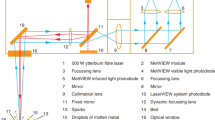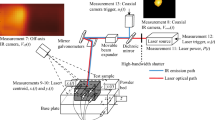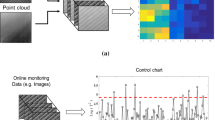Abstract
Multi-laser powder bed fusion (ML-PBF) adopts multiple laser-scanner systems to increase the build envelope and build speed, but its calibration is an iterative and time-consuming process. In particular, multiple large-scale scan fields have a complex distortion in the overlap area, challenging the calibration process. In this study, owing to the enormous workload and alignment problems in the calibration of multiple scan fields, a novel calibration system is designed in this study to realize in situ auto-detection of numerous laser spots in the build chamber to ensure high efficiency and accuracy. Moreover, because the detectable area could not cover the entire build area and the detection data still contained errors, a virtual laser-scanner system was established by identifying the assembly defects and galvo nonlinearities of the ML-PBF system from the detection data, which served as the system's controller to improve calibration accuracy. The multi-field alignment error was less than 0.012%, which could avoid the intersection and separation of scan paths in multi-laser scanning and therefore meet the requirements for high-precision ML-PBF. Finally, the reliability of the method was verified theoretically using principal component analysis.
















Similar content being viewed by others
References
Keremes JJ, Haynes JD, Gao Y et al (2013) Laser configuration for additive manufacturing. In US Patent Application: US 20130112672 A1
Masoomi M, Thompson SM, Shamsaei N et al (2017) Laser powder bed fusion of Ti-6Al-4V parts: thermal modeling and mechanical implications. Int J Mach Tools Manuf 118:73–90
Keicher DM, Miller WD (2001) Multiple beams and nozzles to increase deposition rate. In US Patent: US6268584
Masoomi M, Thompson SM, Shamsaei N (2017) Quality part production via multi-laser additive manufacturing. Manuf Lett 13:15–20
Zhang CC, Zhu HH, Hu ZH et al (2019) A comparative study on single-laser and multi-laser selective laser melting AlSi10Mg: defects, microstructure and mechanical properties. Mater Sci Eng A 746:416–423
Heeling T, Zimmermann L, Wegener K (2016) Multi-beam strategies for the optimization of the selective laser melting process. In: proceedings of the 27th annual international solid freeform fabrication symposium, The University of Texas at Austin, US
Eberle G, Dold C, Wegener K (2013) Building a vector model representation of a two-axis laser scanhead using numerical analysis for simulation purposes. Int J Model Identif Control 20(3):199–207
Godineau K, Lavernhe S, Tournier C (2017) Opto-mechanical modelling of an additive manufacturing laser scanning head including assembly defects. In: joint special interest groupmeeting between EUSPEN and ASPE: dimensional accuracy and surface finish in additive manufacturing, Leuven, Belgium, 2017
Mayer JR, Parker GA (1994) A portable instrument for 3-D dynamic robot measurements using triangulation and laser tracking. IEEE Trans Robot Autom 10(4):504–516
Li G, Wang Y, Han J et al (2014) Geometry algorithm of galvanometer system correction for rapid prototyping of machine parts. Mach Tool Hydraul 42(19):28–30
Han WP, Meng W, Li YX et al (2011) Error analysis and correction methods of dual galvanometer scanning. Electro-Opt Technol Appl 26(4):14–18
William II (2014) Effective calibration and implementation of galvanometer scanners as applied to direct metal laser sintering. In: Proceedings of the ASPE 2014 spring topical meeting ASPE 2014 spring topical meeting: dimensional accuracy and surface finish in additive manufacturing. American Society for Precision Engineering, Berkeley, CA
Lu Y, Badarinath R, Lehtihet EA et al (2017) Experimental sampling of the Z-axis error and laser positioning error of an EOSINT M280 DMLS machine. Addit Manuf 21(1):501–516
Delgado MAO, Lasagni AF (2016) Reducing field distortion for galvanometer scanning system using a vision system. Opt Lasers Eng 86:106–114
Yeung H, Lane BM, Donmez MA et al (2020) In-situ calibration of laser/galvo scanning system using dimensional reference artefacts. CIRP Ann Manuf Technol 69(1):441–444
Chen G, Zhang Y, Tian P (2020) An error compensation method based on machine vision for laser-processing systems with galvanometers. Appl Phys B 127(1):1–9
Manakov A, Seidel HP, Ihrke I (2011) A mathematical model and calibration procedure for galvanometric laser scanning systems. In: Eisert P, Polthier K, Hornegger J (eds) Vision, modeling, and visualization (2011), Eurographics Association, pp 207–214
Mnerie C, Preitl S, Duma VF (2013) Mathematical model of a galvanometer-based scanner: simulations and experiments. In: Modeling Aspects in Optical Metrology IV, SPIE, 2013. https://doi.org/10.1117/12.2020462
Chen MF, Chen YP (2007) Compensating technique of field-distorting error for the CO2 laser galvanometric scanning drilling machines. Int J Mach Tools Manuf 47(7/8):1114–1124
Xie J, Huang SH, Duan ZC et al (2005) Correction of the image distortion for laser galvanometric scanning system. Opt Laser Technol 37(4):305–311
Godineau K, Lavernhe S, Tournier C (2019) Calibration of galvanometric scan heads for additive manufacturing with machine assembly defects consideration. Addit Manuf 26:250–257
Matsuka D, Tanaka T, Iwasaki M (2016) Thermal demagnetization compensation for fast and precise positioning in galvanometer scanners. IEEE Trans Ind Electron 63(9):5514–5522
Zaeh M, Pieczona S (2018) Adaptive inverse control of a galvanometer scanner considering the structural dynamic behavior. CIRP Ann 67(1):385–388
Blais F (1988) Control of low inertia galvanometers for high precision laser scanning systems. Opt Eng 27(2):104–110
Seki K, Kannami H, Iwasaki M et al (2010) Application of self-sensing actuation using piezoelectric element for vibration suppression of galvanometric mirror. In: 2010 IEEE/ASME international conference on advanced intelligent mechatronics, IEEE, 2010
Hu C, Wang X, Song B (2020) High-performance position-sensitive detector based on the lateral photoelectrical effect of two-dimensional materials. Light Sci Appl 9(1):1–9
Zhang WG, Guo W, Zhang CW et al (2019) An improved method for spot position detection of a laser tracking and positioning system based on a four-quadrant detector. Sensors 19(21):1–18
Lasemi A, Xue D, Gu P (2016) Accurate identification and compensation of geometric errors of 5-axis CNC machine tools using double ball bar. Meas Sci Technol 27(5):1–17
Aylward RP (2003) Advanced galvanometer-based optical scanner design. Sens Rev 23:216–222
Mnerie C, Preitl S, Duma VF (2017) Galvanometer-based scanners: mathematical model and alternative control structures for improved dynamics and immunity to disturbances. Int J Struct Stab Dyn 17(5):1740006. https://doi.org/10.1142/S0219455417400065
Yeung H, Lane BM, Donmez MA et al (2018) Implementation of advanced laser control strategies for powder bed fusion systems. Procedia Manuf 26:871–879
Moylan S, Slotwinski J, Cooke A et al (2014) An additive manufacturing test artifact. J Res Natl Inst Stand Technol 119:429–459
Moylan S, Cooke A, Jurrens K et al (2012) A review of test artifacts for additive manufacturing. Report No. NISTIR, 7858, National Institute of Standards and Technology (NIST), Gaithersburg, MD. https://doi.org/10.6028/NIST.IR.7858
Lo YL, Liu BY, Tran HC (2019) Optimized hatch space selection in double-scanning track selective laser melting process. Int J Adv Manuf Technol 105(7/8):2989–3006
Norliza A, Ahmad MH, Robiah A (2006) A comparative study on some methods for handling multicollinearity problems. Mathematika 22(2):109–119
Raychaudhuri S, Stuart JM, Altman RB (2000) Principal components analysis to summarize microarray experiments: application to sporulation time series. In: Biocomputing 2000, World 726 Scientific, pp 455–466
Acknowledgments
This study was supported by the National High Technology Research and Development Program of China (863 Program) (Grant No. 2015AA042503), and the K. C. Wong Education Foundation.
Author information
Authors and Affiliations
Corresponding author
Rights and permissions
About this article
Cite this article
Zhong, Q., Tian, XY., Huang, XK. et al. High-accuracy calibration for multi-laser powder bed fusion via in situ detection and parameter identification. Adv. Manuf. 10, 556–570 (2022). https://doi.org/10.1007/s40436-022-00392-3
Received:
Revised:
Accepted:
Published:
Issue Date:
DOI: https://doi.org/10.1007/s40436-022-00392-3




